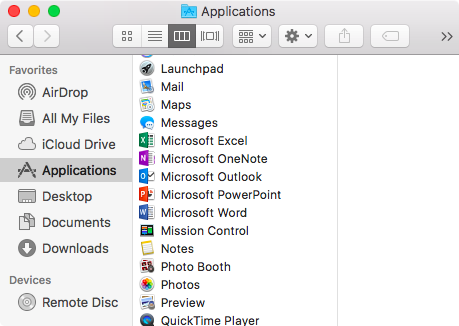Outlook For Mac 2016 Cannot Log In
- Outlook For Mac 2016 Cannot Log Install
- Outlook For Mac 2016 Cannot Log Internet Explorer
- Outlook Cannot Log On 2019
- Outlook 2016 for Mac; In this article. Original KB number: 2648915. This article contains information about the compatibility of Microsoft Outlook for Mac and Apple iCloud. Outlook for Mac does not support Apple iCloud calendar (CalDAV) and contact (CardDAV) synchronization. Outlook for Mac does support iCloud Mail.
- Outlook.com is a free personal email service from Microsoft that doesn't scan your email for the purpose of serving you ads. Automatically file emails and share photos easily.
- Windows 10; Outlook 2016 iCloud for Windows installed. MacOS Sierra 10.12.4 Outlook 2016. I have my @me.com email account working fine on my iPhone 6 but Outlook on both Win & Mac won't sync. Windows is syncs with iCloud Drive. I use iCloud for windows to installs imap setting into Outlook.
- Outlook 2016 cannot connect your email account because the username or password it is using is incorrect. Resolution Check your email password is correct and you are using your full email address, for example. Info@example.com, for the username in your Outlook 2016 settings.
Office 2016 for Mac is a version of Office that’s available as a one-time purchase from a retail store or through a volume licensing agreement. It will be supported with security updates and bug fixes, as needed, until October 13, 2020. The minimum supported macOS for Office 2016 for Mac is 10.10 (Yosemite).
Original KB number: 3014451


Symptoms
Microsoft Outlook 2016 for Mac crashes immediately after startup. The crash reporter displays the following error information.

Exception Type: EXC_BREAKPOINT (SIGTRAP)
Exception Codes: 0x0000000000000002, 0x0000000000000000Application Specific Information:
dyld: launch, loading dependent librariesDyld Error Message:
Library not loaded: @rpath/osfcore.framework/Versions/A/osfcore
Referenced from: /Applications/Microsoft Outlook.app/Contents/MacOS/Microsoft Outlook
Reason:image not found
Cause
This problem occurs if the underlying file system is formatted as case-sensitive. In this scenario, the file is named OsfCore.framework. However, Outlook 2016 for Mac looks for a file that is named osfcore.framework and cannot find the file inside the app bundle.

Outlook For Mac 2016 Cannot Log Install
Workaround
To work around this problem, rename the OsfCore.framework file as osfcore.framework. To do this, follow these steps:
- In Finder, open the Application folder.
- Right-click Microsoft Outlook, and then select Show Package Contents.
- Open the Frameworks folder, and then find the OsfCore.framework file.
- Select OsfCore.framework, press Return, and then change the file name to osfcore.framework.
More information
You can use Disk Utility to determine whether the file system is formatted as case-sensitive. To do this, run Disk Utility, select the hard disk drive partition, and then select the Erase tab to view the Format option that's selected. If either of the case-sensitive options are selected, you may experience this problem.
-->Original KB number: 3007307
Symptoms
When you open your Calendar in Microsoft Outlook 2016 for Mac, the Open Shared Calendar button on the ribbon is unavailable.
Additionally, when you point to Open on the File menu, the Calendar option is unavailable.
Cause
This issue occurs if the Group similar folders, such as Inboxes, from different accounts check box is selected and the Hide On My Computer folders check box is cleared in General Preferences.
Workaround
To work around this issue, use one of the following methods:
Outlook For Mac 2016 Cannot Log Internet Explorer
Select the Exchange folder in My Calendars.
Open the calendar.
Expand My Calendars to display the Exchange mailbox calendar, the On My Computer calendar, and calendars that are associated with any other accounts that are open in Outlook for Mac.
Select the Exchange check box.
After you do this, the Open Shared Calendar button on the ribbon is available.
Open another user's Calendar.
On the File menu, point to Open, and then select Other Users Folder.
Search for and then select the user whose calendar you want to open.
In the Folder Type box, select Calendar.
Select Open.
Change the preferences settings that are related to the On My Computer folders.
- On the Outlook menu, select Preferences.
- Select General.
- Clear the Group similar folders, such as Inboxes, from different accounts check box.
- If you want, select the Hide On My Computer folders check box.